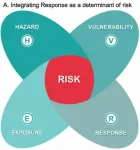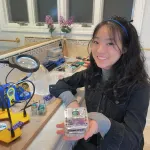(Press-News.org) BOSTON - At the start of the COVID-19 pandemic, very little was known about SARS-CoV-2, the virus that causes COVID-19. Over the past year, more evidence has become available on how the virus is transmitted, who is at the greatest risk and best practices to prevent exposure. Yet questions still remain about how the virus impacts the health of pregnant women and newborns.
In a new study published in JAMA Network Open, physician-researchers from Beth Israel Deaconess Medical Center (BIDMC), Brigham and Women's Hospital, Boston Children's Hospital and Massachusetts General Hospital reveal that, while mother-to-newborn transmission of the virus is rare, newborns of expectant mothers with COVID-19 can suffer indirect adverse health risks as a result of worsening maternal COVID-19 illness.
"At the start of the pandemic, there was very little data to guide evidence-based newborn care practices," said corresponding author Asimenia Angelidou, MD, PhD, a neonatologist at BIDMC. "We believe ours is the first study to dive into the risk factors for mother-to-newborn SARS-CoV-2 transmission. We expected the mode of delivery and/or the degree of maternal illness to increase the risk of newborn infection, but were surprised to find that this was not the case."
Examining neonatal outcomes during the first month of life for babies born at 11 hospitals that represent approximately 50 percent of all births in Massachusetts, the team identified 255 neonates delivered between March 1 - July 31, 2020, to mothers with a recent positive SARS-CoV-2 test result. The researchers used the American Academy of Pediatrics' National Registry for Surveillance and Epidemiology of Perinatal COVID-19 Infection complemented by a Massachusetts-specific Registry. Out of the 255 neonates studied, 88.2 percent were tested for SARS-CoV-2, and only 2.2 percent had positive results. However, while infection rates among newborns were relatively low, worsening maternal illness accounted for 73.9 percent of preterm births. Premature birth can often lead to acute and chronic complications, including respiratory distress, chronic health problems and developmental disabilities.
"We found that of babies born to mothers with COVID-19, very few babies tested positive," said senior author Mandy Brown Belfort, MD, MPH, Director of Clinical Research in the Department of Pediatric Newborn Medicine at Brigham and Women's Hospital and Associate Professor of Pediatrics at Harvard Medical School. "Instead, the adverse health impact of maternal COVID-19 on the newborn was from preterm delivery, usually prompted by a mother's worsening illness. Our findings support the need for thoughtful and collaborative decision-making around delivery timing in the setting of maternal COVID-19 illness."
Other indicators of adverse infant health outcomes the researchers incorporated in their analysis included low birth weight or very low birth weight, need for delivery room resuscitation, length of hospital stay and healthcare utilization for non-routine visits within a month after discharge.
The team found that short-term adverse outcomes were most closely associated with preterm birth and its consequences, rather than infection of the newborn with the virus. However, newborns of socially vulnerable mothers, as determined using a tool created by the Centers for Disease Control and Prevention using residential zip-codes, were at an increased risk for testing positive. The specific pathways by which social vulnerability might affect mother-to-child transmission of COVID-19 include differential access to care and clinician bias. Discrimination may also be a factor in chronic stress, which can diminish antiviral immune responses.
"This observation that newborns of socially vulnerable mothers were five times more likely to have COVID-19 highlights that health disparities are very complex and extend beyond race, ethnicity and language status," said Angelidou, who is also Instructor in Pediatrics at Harvard Medical School. "Social vulnerability likely affects health and immunity and our study supports further research in this area. Reallocation of resources to socially vulnerable communities could go a long way in decreasing human suffering and economic loss during disease outbreaks."
The authors suggest further research on perinatal viral transmission should include women with COVID-19 early in pregnancy in order to identify the window of highest susceptibility to the virus for mother and baby during pregnancy. Conversely, future research including pregnant women immunized against COVID-19 is important to inform the optimal window for maximal neonatal protection after maternal immunization.
"While the low rates of neonatal infection we observed are reassuring, it is important that providers remain vigilant." said Angelidou, who is also a scientist at the Precision Vaccines Program in the Division of Infectious Diseases at Boston Children's Hospital. "Even during public health emergencies like the ongoing pandemic, providers need to carefully monitor newborns for atypical signs of the illness, while also trying to avoid unnecessary premature deliveries that pose inherent risks for both mother and child."
INFORMATION:
In addition to Angelidou and Belfort, co-authors included Neha Chaudhary, Ivana Culic and Diana Yanni of BIDMC, Katherine Sullivan of UMass Memorial Health Center, Patrice R. Melvin of Boston Children's Hospital, Jessica E. Shui and Ilona Telefus Goldfarb of Massachusetts General Hospital; Ruby Bartolome and Margaret G. Parker of Boston Medical Center; Ruben Vaidya of University of Massachusetts Medical School-Baystate; Rachana Singh of Tufts Children's Hospital; Silvia Patrizi of Brigham and Women's Hospital; and Mark L. Hudak of the University of Florida College of Medicine.
This work was supported in part by the W. K. Kellogg Foundation (PO131665).
Angelidou reported receiving support from the Mueller Health Foundation as well as honoraria for lectures on neonatal health and authorship of an article on neonatal vaccination from NeoReviews. Belfort reported receiving grants from the National Institutes of Health, Allen Foundation, Gerber Foundation, and Gates Foundation outside the submitted work. No other disclosures were reported.
About Beth Israel Deaconess Medical Center
Beth Israel Deaconess Medical Center is a patient care, teaching and research affiliate of Harvard Medical School and consistently ranks as a national leader among independent hospitals in National Institutes of Health funding. BIDMC is the official hospital of the Boston Red Sox. For more information, visit http://www.bidmc.org.
Beth Israel Deaconess Medical Center is a part of Beth Israel Lahey Health, a health care system that brings together academic medical centers and teaching hospitals, community and specialty hospitals, more than 4,000 physicians and 35,000 employees in a shared mission to expand access to great care and advance the science and practice of medicine through groundbreaking research and education. END
(Boston)-- Being a parent of a Neonatal Intensive Care Unit (NICU) infant does not come with its own playbook of instructions. Preparing to care for a medically needy infant requires the mastery of technical skills, knowledge, emotional comfort and confidence. After confirming that an infant is medically ready for discharge, the quality of NICU discharge training/teaching is the strongest predictor of discharge readiness. A new study reinforces the importance of discharge preparation and transition to home planning.
NICU discharge readiness is defined as the "masterful attainment of technical skills and knowledge, emotional ...
Evolution is unfolding in real time within many natural animal populations and researchers are now observing how this influences biodiversity in the field. In a newly published study in Molecular Ecology a team of Drexel University scientists examined the biological variations in pea aphids, insects that reproduce frequently enough to evolve before our eyes, by tracing the prevalence of their protective endosymbiont, Hamiltonella defensa, which the insects use to ward off parasitoid wasps.
"We know that certain organisms have many generations in a season, and we know sometimes it just takes a handful of generations for evolution to unfold; and aphids are one of those types of organisms," explained END ...
DES PLAINES, IL - The diagnostic value of the Head-Impulse, Nystagmus, Test of Skew (HINTS) exam in the emergency department setting is limited. This is the result of a study titled END ...
It's been hailed as a wonder drug and it's certainly creating wonder profits. By some estimates, the Cannabidiol (or CBD) market could be worth $20 billion dollars by 2024. While users tout its effectiveness in pain relief, up until now there's been limited experimental human research on the actual effectiveness of the drug. However, a new study led by researchers at Syracuse University sheds light on the ability of CBD to reduce pain along with the impact that the so-called placebo effect may have on pain outcomes.
"For science and the public at large the question remained, is the pain relief that CBD users claim to experience due to pharmacological effects or placebo effects," asked Martin De Vita, a researcher in the psychology department at Syracuse University's ...
Researchers from Trinity College Dublin have discovered that some skeletal defects associated with a lack of movement in the womb during early development may still be ameliorated after such periods of immobility if movement resumes.
The researchers' discovery was made using chicken embryos, which develop similarly to their human equivalents and which can be easily viewed as development takes place - raising hopes that the finding may also apply to humans and thus have important implications for therapeutic interventions.
The research has just been published in leading international journal, Disease Models and Mechanisms.
Why babies need to move in the womb
Foetal movement in the uterus is a normal part of a healthy ...
The new alloys created by NUST MISIS scientists in cooperation with LG Electronics will help reduce the weight of radiators and heat removal systems in electric vehicles and consumer electronics by one third. The research results are published in the Journal of Magnesium and Alloys.
According to experts, with the development of electronics the problem of efficient heat removal is becoming more and more acute -- with an increase in the productivity of equipment, heat generation also grows. Reducing the temperature directly affects the prolongation of the devices' life cycle. This is especially important for household appliances, electric vehicles, LED panels.
Scientists from NUST MISIS, in collaboration with LG Electronics, ...
"Jack and Jill went up the hill to fetch a pail of water." It's a silly rhyme, but one that highlights a simple fact: Humans have long relied on wells -- such as the one on the hill visited by Jack and Jill -- for their primary drinking water supply.
Although the number of people who draw their water by pail is declining as pumps become ever more widespread, groundwater wells still supply drinking water to more than half of the world's population and sustain over 40% of irrigated agriculture. But this vital resource underfoot often gets overlooked.
UC Santa Barbara assistant professors Debra Perrone and Scott Jasechko have compiled the most comprehensive assay of groundwater wells to date, spanning 40 countries that collectively account for half of all global groundwater ...
A team of researchers from the Africa Climate and Development Initiative (ACDI) led a global team of 21 climate risk scholars to better understand and inform decision making around climate change risks in Africa and globally by examining how the drivers of risk interact.
Their work extends on existing risk frameworks with the hope that this research could help decision makers, managers and researchers understand the inherent complexity of climate change.
"Understanding the interactions among risks holds potential to change the way we respond to the risks. This is important because policy makers may worry about the risk of implementing a response as much, or more so, than the risk ...
A Southern California high school junior has built a low-cost seismometer device that delivers earthquake early warnings for homes and businesses. Costing less than $100 for her to make today, the seismometer could someday be a regular household safety device akin to a smart smoke detector, says its inventor Vivien He.
About the size of a Rubik's cube and encased in clear acrylic, the seismometer has a sleek, consumer-ready look. The device's geophone detects incoming ground motion, while onboard hardware and software translate the geophone's electrical signals into a digital waveform. The device has detected all earthquakes over magnitude 3.0 around Los Angeles since September 2020.
When ...
At the Seismological Society of America's 2021 Annual Meeting, researchers shared how they are using fiber optic cable to detect the small earthquakes that occur in ice in Antarctica.
The results could be used to better understand the movement and deformation of the ice under changing climate conditions, as well as improve future monitoring of carbon capture and storage projects, said Anna Stork, a geophysicist at Silixa Ltd.
Stork discussed how she and her colleagues are refining their methods of distributed acoustic sensing, or DAS, for microseismicity--earthquakes too small to be felt. DAS works by using the tiny internal flaws within an optical fiber as thousands of seismic ...





